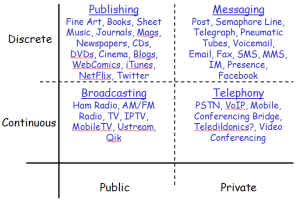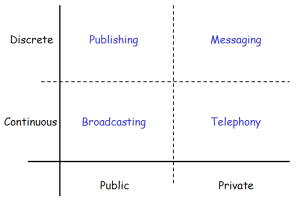After I’d written the previous post on Communications Industries, I worried that the two properties that I’d used as the axes to obtain the set of four industries were perhaps the wrong ones. I suspect that for any 2 x 2 matrix, there are probably an infinite set of alternative axes that produce a given set of contents. For example, instead of the public/private distinction, I might have chosen asymmetric/symmetric. But that said, the properties “feel” like good ones to me, so I’ll stick with them for now, while allowing myself to luxury to throw them away later if they turn out not to work.
Anyway, to continue my musing…
Taking the 2 x 2 matrix from last time, and populating it with examples of the products and businesses within those industries is helpful in building up a picture of the characteristics of each quadrant:
 One of the first observations is that all of these examples of communications require some sort of network. The different quadrants have different types of networks, clearly. I’m interested in seeing if there are some common characteristics shared by the examples in the e.g. public or discrete categories.
One of the first observations is that all of these examples of communications require some sort of network. The different quadrants have different types of networks, clearly. I’m interested in seeing if there are some common characteristics shared by the examples in the e.g. public or discrete categories.
Another observation is that the older examples make use of analogue or manual methods, while the newer examples are digital or electronic. Analogue technologies are probably better aligned with a continuous approach to communicating, as digital technologies are, almost by definition, discrete approaches. Bits are bundled together into packets, and sent across the network in discrete chunks. However, each chunk may carry something very small, perceptually, and so can effectively emulate a continuous channel.
It seems that in gathering up examples, I have found comparatively fewer examples of continuous communication than distinct communication. An explanation of this could be that discrete communication has historically been based around a particular physical medium (a letter, a pneumatic capsule, a book, a film reel, a CD, etc.) which was the means of expressing the communication. The large variety of physical media possible have resulted in different products and businesses based around them, and the characteristics of those products have been carried forward into the digital world. (Although without the conservative force of those physical constraints, we are seeing some of them merge.)
On the other hand, continuous communication networks developed after their discrete cousins, when technology was finally able to capture and transmit two of the senses we use to experience performances. Aside from the relationship to a particular sense, there was no physical medium to constrain the communication, and hence the communications networks were more versatile. Fewer types of continuous communications networks were needed to accommodate the range of things people wanted to communicate. Any sort of performance at a venue (theatre, concert hall, sporting ground, office, or home) could be conveyed to somewhere else.
That said, there are definitely constraints of various kinds on continuous communications networks. The other senses that might be used if you were physically present are not accommodated. In terms of vision, you are provided with only a window into the other end, rather than the whole vista. In terms of sound, you are provided with a limited frequency and dynamic range as well as a loss of some of the spacial characteristics. But, unlike some of the discrete communications options, there is also a much reduced need for literacy, as the experience aims to provide a “natural interface” through conveying key human senses.
I think I’ll leave this discussion there for now, and pick up the differences between public and private later.
Related articles by Zemanta
- It’s all about communication (digital-constructions.com)
- 5 Levels of Effective Communication in the Social Media Age (listropolis.com)
- Why Integrated Communications Are Better? (georgevanantwerp.com)
- Cell phones don’t ring everyone’s bell (textually.org)
![Reblog this post [with Zemanta]](http://img.zemanta.com/reblog_e.png?x-id=57ef8ddb-39b0-417f-9c8a-b4593a666d27)

![Reblog this post [with Zemanta]](http://img.zemanta.com/reblog_e.png?x-id=9912f7b3-496c-48dd-939b-048bdb8aafd8)